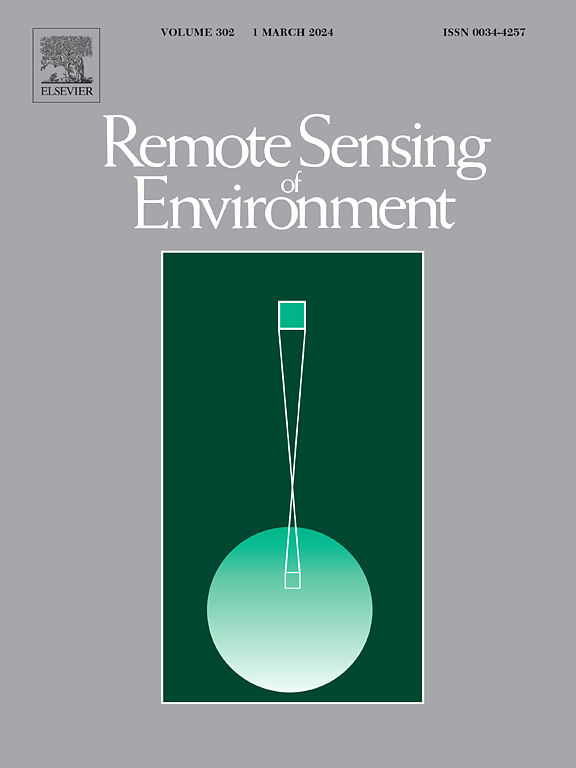基于机器学习的SAR图像与CYGNSS数据融合监测河流水位变化
IF 11.4
1区 地球科学
Q1 ENVIRONMENTAL SCIENCES
引用次数: 0
摘要
准确的河流水位估算对有效的洪水监测和水资源管理至关重要。然而,传统技术和单卫星观测的精度和分辨率较低。在本文中,我们提出了一种基于先进机器学习技术的新方法,通过融合Cyclone全球导航卫星系统(CYGNSS)数据和Sentinel-1合成孔径雷达(SAR)图像来增强河流水位估计。SAR提供高分辨率、全天候的表面图像,而来自八颗CYGNSS任务的GNSS-Reflectometry提供频繁和广泛覆盖的观测。通过提取Sentinel-1后向散射系数的变化,并将其与CYGNSS数据的高时间分辨率特征相结合,以日时间分辨率获得动态河流水位。为了保证模型的稳健性,采用了十倍交叉验证(CV)程序,并纳入了15个均匀分布的测量点。实验结果表明,数据融合方法显著提高了时间分辨率,更重要的是提高了水位估计的精度。与未进行数据融合的模型相比,优化后的融合算法将RMSE从0.341降低到0.168 m,降低了50.74%,R从0.876提高到0.936。在15个站点中,有8个站点的RMSE改善超过35%。为了进一步验证模型的普遍性,我们使用8个时空独立的水文站的数据进行了测试。融合方法将RMSE从0.479降低到0.202 m, R从0.848提高到0.927,进一步验证了融合方法在提高水位估计中的有效性。研究结果表明,将SAR图像与CYGNSS时间序列数据相结合具有互补效应,可以更好地估算水位。本文章由计算机程序翻译,如有差异,请以英文原文为准。
Fusing SAR image and CYGNSS data for monitoring river water level changes by machine learning
Accurate river water level estimation is essential for effective flood monitoring and water resources management. However, traditional techniques and single satellite observations have low accuracy and resolution. In this paper, we propose a novel method to enhance river water level estimation by fusing Cyclone Global Navigation Satellite System (CYGNSS) data and Sentinel-1 Synthetic Aperture Radar (SAR) imagery based on advanced machine learning (ML) techniques. SAR provides high-resolution, all-weather surface imagery, while the GNSS-Reflectometry from the eight-satellite CYGNSS mission offers frequent and wide-coverage observations. Dynamic river water levels are obtained at a daily temporal resolution by extracting changes in Sentinel-1 backscattering coefficients and integrating them with the CYGNSS data's high temporal resolution feature. To guarantee the model's robustness, a ten-fold cross-validation (CV) procedure is used with incorporating 15 uniformly distributed gauge sites. Experimental results show that the data fusion method significantly improved the temporal resolution, and more importantly the precision of water level estimation. As opposed to the model without data fusion, the optimized fusion algorithm achieved a 50.74 % reduction in RMSE from 0.341 to 0.168 m, while the R was improved from 0.876 to 0.936. An improvement of over 35 % in RMSE was observed at 8 out of 15 stations. To further validate the model's generalizability, we tested it using data from 8 spatially and temporally independent hydrological stations. The fusion method reduced the RMSE from 0.479 to 0.202 m and increased the R from 0.848 to 0.927, further confirming its effectiveness in enhancing water level estimation. The findings indicate that integrating SAR imagery and CYGNSS time series data has complementary effects and enables better water level estimation.
求助全文
通过发布文献求助,成功后即可免费获取论文全文。
去求助
来源期刊

Remote Sensing of Environment
环境科学-成像科学与照相技术
CiteScore
25.10
自引率
8.90%
发文量
455
审稿时长
53 days
期刊介绍:
Remote Sensing of Environment (RSE) serves the Earth observation community by disseminating results on the theory, science, applications, and technology that contribute to advancing the field of remote sensing. With a thoroughly interdisciplinary approach, RSE encompasses terrestrial, oceanic, and atmospheric sensing.
The journal emphasizes biophysical and quantitative approaches to remote sensing at local to global scales, covering a diverse range of applications and techniques.
RSE serves as a vital platform for the exchange of knowledge and advancements in the dynamic field of remote sensing.
 求助内容:
求助内容: 应助结果提醒方式:
应助结果提醒方式:


